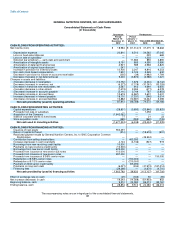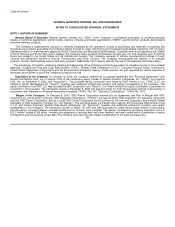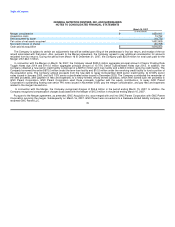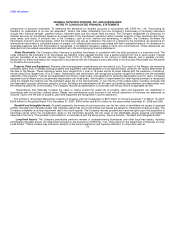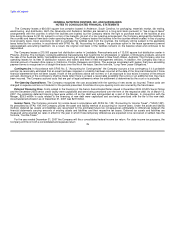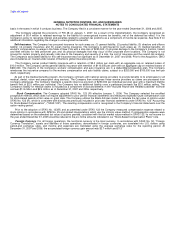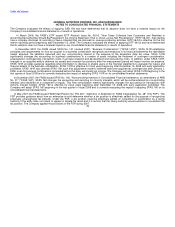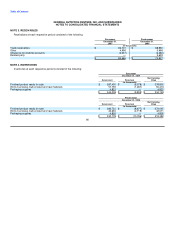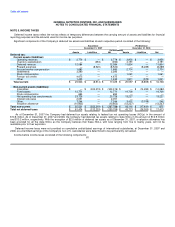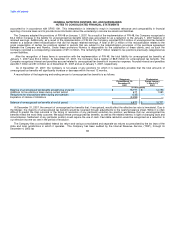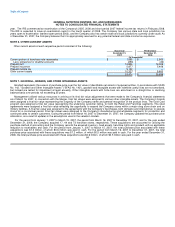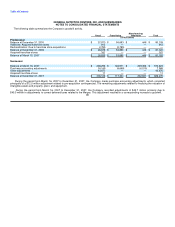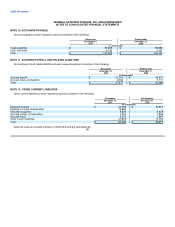GNC 2008 Annual Report Download - page 82
Download and view the complete annual report
Please find page 82 of the 2008 GNC annual report below. You can navigate through the pages in the report by either clicking on the pages listed below, or by using the keyword search tool below to find specific information within the annual report.
Table of Contents
GENERAL NUTRITION CENTERS, INC. AND SUBSIDIARIES
NOTES TO CONSOLIDATED FINANCIAL STATEMENTS
million, respectively. Gains or losses resulting from foreign currency transactions are included in results of operations.
Financial Instruments and Derivatives. As part of the Company's financial risk management program, it uses certain derivative financial
instruments. The Company does not enter into derivative transactions for speculative purposes and holds no derivative instruments for trading
purposes. The Company uses derivative financial instruments to reduce its exposure to market risk for changes in interest rates primarily in
respect of its long term debt obligations. The Company tries to manage its interest rate risk in order to balance its exposure to both fixed and
floating rates while minimizing its borrowing costs. To achieve these objectives, the Company primarily uses interest rate swap agreements to
manage exposure to interest rate changes related to its senior credit facility borrowings. These interest rate swap agreements are primarily
designated as cash flow hedges. The Company measures hedge effectiveness by assessing the changes in the fair value or expected future
cash flows of the hedged item. The changes in the fair value of the hedges are reported in other long term assets or liabilities in the
consolidated balance sheet. At December 31, 2007, the Company had interest rate swap agreements outstanding that effectively converted
notional amounts of $300.0 million of debt from floating to fixed interest rates. The outstanding agreements mature in April 2009 and April 2010.
The Company would have paid $5.6 million ($3.6 million net of tax) at December 31, 2007 to settle these interest rate swap agreements, which
represents the fair value, including accrued interest of $0.2 million, of these agreements on that date. This amount is included in comprehensive
income at December 31, 2007.
Recently Issued Accounting Pronouncements.
In February 2007, the Financial Accounting Standards Board, ("FASB") issued SFAS No. 159 "The Fair Value Option for Financial Assets
and Financial Liabilities—Including an amendment of FASB Statement No. 115" ("SFAS 159"). SFAS 159 expands the use of fair value
accounting but does not affect existing standards which require assets or liabilities to be carried at fair value. The objective of SFAS 159 is to
improve financial reporting by providing companies with the opportunity to mitigate volatility in reported earnings caused by measuring related
assets and liabilities differently without having to apply complex hedge accounting provisions. Under SFAS 159, a company may elect to use
fair value to measure eligible items at specified election dates and report unrealized gains and losses on items for which the fair value option
has been elected in earnings at each subsequent reporting date. Eligible items include, but are not limited to, accounts and loans receivable,
available-for-sale and held-to-maturity securities, equity method investments, accounts payable, guarantees, issued debt and firm
commitments. SFAS 159 is effective for fiscal years beginning after November 15, 2007. The Company continues to evaluate the adoption of
SFAS 159 and the impact on its consolidated financial statements or results of operations.
In September 2006, the FASB issued SFAS No. 157, "Fair Value Measurements." This Statement defines fair value, establishes a
framework for measuring fair value in generally accepted accounting principles, and expands disclosures about fair value measurements. The
Statement applies under other accounting pronouncements that require or permit fair value measurements and, accordingly, does not require
any new fair value measurements. This statement was initially effective as of January 1, 2008, but in February 2008, the FASB delayed the
effectiveness date for applying this standard to nonfinancial assets and nonfinancial liabilities that are not currently recognized or disclosed at
fair value in the financial statements. The effectiveness date of January 1, 2008 applies to all other assets and liabilities within the scope of this
standard. The Company does not expect any material financial statement implications relating to the adoption of this Statement.
In September 2006, the SEC issued Staff Accounting Bulletin No. 108, "Considering the Effects of Prior Year Misstatements when
Quantifying Misstatements in Current Year Financial Statements" ("SAB 108"). This bulletin expresses the SEC's views regarding the process
of quantifying financial statement misstatements. The interpretations in this bulletin are being issued to address diversity in practice in
quantifying financial statement misstatements and the potential under current practice for the build up of improper amounts on the balance
sheet. This statement is effective for annual financial statements with years ending December 31, 2006. We have adopted SAB 108 for the year
ended December 31, 2006. 78


